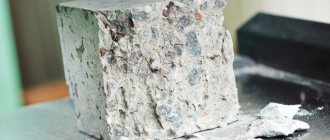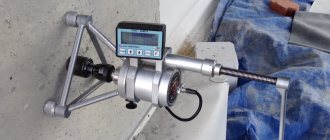The quality and properties of concrete are determined by several criteria. Among them, strength is one of the basic ones. Let's consider B25 concrete: what grade of material is, composition, technical characteristics and application. Let's get acquainted with the factors that can influence the characteristics of the finished solution. After reading the article, specialists will have significantly fewer questions, and it will be easier to decide between the composition from the manufacturer and the one prepared at the construction site.
Marking of concrete class B25 Source tildacdn.com
Concepts of strength: brand and class
Modern marking of a cement composite involves indicating two parameters at once that are associated with strength characteristics. Let's look at these concepts and B25 concrete - what brand it is.
Brand strength means the maximum endurance of the dry residue to compressive loads. The result is an average based on data obtained 7, 14, 28 days after pouring the monolith. The parameter (M) is measured in kgf/sq.cm, and can range from 20 to 1000 units. The permissible error from the declared value is 13.5%.
The strength class is determined based on testing cubic samples of dry residue. Here, endurance before compressive load is measured in MPa, the probability of compliance with the established marking (B) is not lower than 93-95%. Value range: 7.5 to 60.
Strength testing of concrete samples Source 2gis.com
It is easy to determine what grade of concrete class B25 is. There is a ready-made table compiled according to the technical conditions of the current GOST of 1991 (26633). According to the standards, the composite belongs to the M350 brand.
Prestressed concrete structures
A structure or element made of reinforced concrete, loaded with artificially created internal stresses, directed opposite to the real physical loads during operation of the object. Artificial stresses appear after prestressed reinforcement is introduced into the body of the structure. You can do it like this:
- When pouring the solution, grooves are left in the structure into which the reinforcement (mesh, rods, spirals) is placed. The strength gain is completed by tensioning the reinforcing mesh or other type of reinforcement with the ends fastened to the sides of the element. The tension of the reinforcement is accompanied by compression of the concrete. The tension force is indicated by the symbol “P”;
- The reinforcement is tensioned before pouring the mortar (the so-called tension on the stops), and after the mixture has hardened, it is released, which creates compressive stress.
Another option for creating prestressing is pouring special tensile cement grade NTs. As it hardens, the volume of a structure made of this grade of cement increases, and the reinforcement also stretches, creating tensile stress.
Technical description of concrete B25
The properties of a cement composite are determined by its composition. Manufacturers of the material are regulated by state standards 26633-2012 and 7473-2010. These are updated GOSTs from 1991 and 1994, respectively. Compared to other brands of cement mortar, M350 occupies a leading position in demand. Let's look at the reasons for this situation, which are based on the properties of the material.
Compound
Let's look at what components are included in concrete B25 grade M350. The basic ingredients are:
- Cement. The binder here must be of a high grade. Most often this is Portland cement from M400 (CEM I 32.5H).
- Sand. The material acts as a sealant. The purified component is used with a fraction of 1.5 to 2.5 mm.
- Gravel. Solid aggregate is usually limestone or granite in nature. The grain size is average, ranging from 20 to 40 mm.
Let's look at the recipe for concrete B25 grade M350 in the table below. Here is the dependence on the binder used.
| Components | For CEM I 32.5H (M400) | For CEM I 42.5H (M500) | ||
| In kg | In volumetric parts | In kg | In volumetric parts | |
| Cement | 1 | 1 | 1 | 1 |
| Sand | 1,5-1,6 | 1,1-1,4 | 1,9 | 1,6 |
| Coarse aggregate | 2,7-3,1 | 2,4-2,8 | 3,6-3,9 | 3,2 |
See also: Catalog of companies that specialize in calculation, installation and repair of foundations
It also contains pure water with minimal impurities. Liquid content is limited to 45%. It is permissible to additionally add additives to adjust characteristics such as frost resistance, mobility or hydrophobicity.
Plasticizer for concrete mortar Source stroysam-shop.ru
Properties
Based on the M350 B25 marking, the user can determine the strength properties of concrete. Thus, this composite is on average capable of withstanding a compressive load ranging from 327 to 368 kgf/sq.cm. The guaranteed strength (with an error of 5-7%) is 25 MPa, but it is possible to increase the limit to 27.5 MPa.
Other technical characteristics of the material are presented in the table below.
| Density | 1800-2400 kg/cub.m | The relatively wide range of values can be explained by the nature and fraction of the solid aggregate. This particular composite is characterized by high resistance to compression and tension during seasonal changes in the soil. |
| Frost resistance (F) | 200 | The numerical value indicates the permissible number of freezing and thawing cycles of the composite. M350 concrete can be used to form structures in harsh climates. |
| Waterproof (W) | 6-8 | Less commonly, a solution with a W10 index is produced with the addition of additives. The composite has low water absorption (up to 5.5% per day) due to its high density. There are practically no pores here. Therefore, the monolith is applicable to operation in conditions of direct contact with water. |
| Mobility (P) | 2-4 | The plasticity of the working mass is determined by the settlement of the conical sample. Cement mortar B25 is characterized by indicators of 5-9, 10-15 or 16-20 cm. To improve mobility, plasticizers are added to the composition. |
What is Design Resistance
The ability of a product to withstand various mechanical loads shows the design resistance of concrete.
The values obtained during the calculation are abbreviated as RB and RBT; they are necessary for developing projects for various commercial and industrial facilities. This value is obtained from the indicators for the standard of resistance to loads of the specified brand of concrete by dividing by the tabular coefficient γbi.
You can find out the exact calculated compressive strength of concrete using a table that contains figures from mathematical calculations used for the construction of various objects.
This coefficient can be expressed in the following figures:
- 1.3 - for the highest load-bearing capacity;
- 1 - for the highest values of serviceability.
The reliability of concrete under physical tension γbt is expressed in the following coefficients:
- 1.5 - for the highest load-bearing capacity of concrete when establishing its class for the degree of compression;
- 1.3 - for the highest load-bearing capacity for the degree of stretching along the axis;
- 1 - for the highest performance indicators.
In order to find out the exact design resistance of concrete to axial compression, its class should be determined.
From the tabular data, you should take the indicators according to the norm and calculate using the formula Rb=Rbn/γb, where:
- Rb—calculated axial compression figures;
- Rbn—rate multiplier;
- γb—tabular coefficient.
The resistance of concrete products to axial tension is calculated using the formula Rbt=Rbtn/γbt, where:
- Rbt—calculated figures for axial tensile strength;
- Rbtn—rate multiplier;
- γbt — tabular coefficient.
Depending on the factors that will influence the performance capabilities of concrete products,
Other coefficients γbi can also be used:
- 1 - for short-term loads;
- 0.9 - for loads that last for a long time;
- 0.9 - for products that are poured vertically;
- coefficients that indicate natural conditions, the purpose of the concrete product and the cross-sectional area are prescribed separately in the project.
Application area of the composite
The determining parameters regarding the use of a composite are strength and water absorption. Concrete B25 M350 has high performance, so it is used for the construction of outdoor structures under conditions of heavy mechanical load. For example, the material often chosen for paving is:
- pedestrian zone;
- cycle track;
- motorway;
- runway strip.
Runway construction Source zp.gov.ua
Methods for determining strength using control concrete samples
Having understood what the compressive strength of a material is, we will consider the main methods for determining this indicator.
Destructive testing of concrete
Compression testing is usually carried out in accredited construction laboratories using certified equipment. The main thing you need for it is a press.
Accurate laboratory scales, calipers and test specimens will also be required. The latter are prepared in advance from the required batch. The shape is standard - a cube with sides of 10 cm. According to technical documents, from 3 to 5 samples are used for one batch.
Advice. Initially, they need to be prepared by cleaning them from contamination and weighed to determine compliance with the density, weight and design grade of the material. If these values are normal, then you can be 95% sure of the proper level of stability.
The sample is placed on the press with absolutely even edges, turned on and testing begins. The maximum load at which the sample began to fail is the ultimate compression.
The average value is established based on the results of control of all selected samples. The final figure determines whether or not the actual strength corresponds to the standard and design values. After which it is entered into the journal.
Gallery: destructive testing process using a press.
More detailed instructions for testing concrete samples are presented in the video in this article.Non-destructive testing
The previous method is required in any construction industry and at any stage of construction.
It is considered the most reliable:
- Designers and architects rely on the results of laboratory destructive research protocols when constructing buildings and manufacturing reinforced concrete products.
- When it is not possible to determine the strength of samples using a destructive method, or when repeated analysis of the characteristics is required after a certain time, special devices are used.
- They are necessary in order to test the material for compression directly on site. With one light touch they determine the numerical value and, if desired, other necessary characteristics regarding the uniformity and compaction of the material body.
- There is a lot of similar equipment, but the most common in construction circles is the IPS - MG device of various modifications. It is easy to use, accurate and affordable.
Photo of an automated device.
It is mainly used on construction sites. This electronic meter allows you to quickly determine density, strength and elastic-plastic properties using the shock pulse method. Although this method is not a priority, it is still provided for by GOST 22690.
Advice. Before “shooting” the concrete, it is imperative to select or prepare the surface. It must be smooth without roughness, dents, voids, cracks and other defects with an area of at least 100 cm2. If necessary, you need to sand the surface.
The number of sections must be accepted according to the test program, but there must be at least three. Typically, for a volumetric reinforced concrete structure, an average value of 15 samples is taken.
This amount depends on the area, since the control points must be at a distance of 15 mm from each other and at least 50 mm from the edge. Ideal places are between crushed stone granules and large shells in the concrete body.
To test the design, you must:
- turn on the device, and it will immediately be in test mode;
- enter data about the material being tested;
- cock the lever on the “pistol”;
- press firmly perpendicular to the surface being tested and release the lever;
- the result will appear on the scoreboard, it will be remembered for subsequent tests;
- after 15 samples, the average value is automatically displayed; if the number of “shots” is less, then you can view the average result in advance.
What’s good about such a device is that all the data on it can be saved on a computer and archived. You can review previous tests on your computer at any time and create a report.
Briefly about the main thing
To determine which brand B25 concrete corresponds to, you can refer to the technical specifications of GOST 26633-91. This is the M350. Moreover, the class may be higher - B22.5.
The technical characteristics of the material depend on the brand of cement used (M400 and higher), the nature and fraction of the solid mineral aggregate (limestone, granite from 20 to 40 mm in size). The properties are also influenced by the nature of the additives added: water repellent, antifreeze, plasticizer.
The composition is used for laying various roads, constructing buildings of various heights (complex construction), and installing sewer systems.
Axial compression. Calculations and values
When making calculations, it must be taken into account that class (B) directly depends on its average strength R, MPa. Accordingly, the following formula is used:
B = R (1−tV), where t is the security class included in the design, generally take the value 0.95, respectively t = 1.64; V – strength variation coefficient. 1 – constant.
If the standard coefficient V = 13.5% (0.135) was used in the calculations, then the average strength is equal to R = B/0.778.
It’s another matter when all kinds of reinforced concrete structures are calculated. The boundary height of the specified zone is calculated especially carefully. It expresses the height at which, before failure, the stresses in the compressed material and the tensile reinforcement reach their maximum values simultaneously. Only under this condition can the section be considered normally reinforced.
According to SNiP 2.03.01 - 84, the height of the zone is the formula:
Compressed zone height formula
In this case, the relative height of this zone (table) is used for a specific product. They can be found in regulatory documents, and the data can be used in calculations. Basically, the information provided briefly explained what the compression zone and axial compression resistance are.











